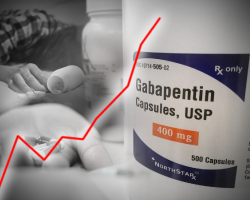An Unrestricted Drug Becomes a New Drug of Abuse

It might seem like every drug likely to be abused by the addicted is kept under lock and key to protect the public. That’s only partly true. Yes, drugs like OxyContin, Vicodin, methadone or morphine are controlled and monitored by doctors, pharmacies and agencies like the Drug Enforcement Administration. So if you show up at your doctor’s office telling them you “dropped your pills in the toilet again” and need a new prescription, you’re not likely to get it. But when a drug is not in the headlines, when it is no more controlled or restricted than cholesterol medication, it’s more accessible to a person who might want to abuse it.
That’s the case with gabapentin, a drug used for the nerve pain of shingles or the damage done by diabetes. It’s also used to control seizures. According to recent reports, its less-restrictive status has made it popular with some people who are in treatment for addiction or don’t have access to their preferred drug.
The Effects of Gabapentin

Why would a person addicted to or being treated for addiction to a different drug reach for gabapentin? While it’s primarily used as an analgesic or anti-seizure medication, it is also prescribed off-label for its sedative effects to treat mood and anxiety problems. A survey done in Appalachia of opioid abusers found that 15% of these people had also abused gabapentin for the purpose of getting high. These people obtained their gabapentin either from a doctor or a drug dealer.
Another study published in Addiction found the following:
“Prevalence of gabapentin misuse in the general population was reported to be 1%,
40-65% among individuals with prescriptions and between 15 and 22% within populations of people who abuse opioids.”
This study found that those misusing the drug reported effects similar to those of opioids, benzodiazepines or psychedelics and that it was often abused in combination with alcohol, opioids or benzodiazepines.
How Do You Prevent Abuse of Less Controlled Drugs?
The real problem is that a person who is immersed in addiction and who does not have a path back to sobriety will find some drug he (or she) can abuse if his preferred drug is not available. A person who can't get painkillers anymore will migrate to heroin. A person who has damaged his liver with alcohol might switch to marijuana. When the underlying need to be impaired by drugs is not addressed, it’s very common for a person to simply find another substance to abuse. As another example, a parent who drug-tests a teen for marijuana use may eventually discover that the young person switched to a synthetic like Spice to evade detection.
This is why short-term rehab programs so often fail. The individual may be free of the influences of drugs at last when he completes that month-long program. But the challenge of his life may still be too much for him without the buffer of some kind of drug or drink.
The solution to lasting sobriety must include addressing the underlying disability that led the person to reach for drugs or alcohol in the first place. Otherwise, even after the individual breaks free from one drug, he could be attracted to another addictive substance or other self-destructive habits.
What must be addressed for real rehabilitation?
- The addicted person could lack sufficient basic life skills
- He (or she) could have experienced sexual or physical abuse that was never addressed
- He may lack goals or have no idea how to achieve them.
These are just a few of the many reasons a person may have thought it was a good idea to start drinking, smoking pot or using other drugs. If they are not sufficiently addressed in rehab, they could send him back to substance abuse after rehab.
Of course, once the body adapts to the continuing presence of a drug, the cravings make it so much harder to break free. That’s a whole other layer of entrapment that rehabilitation must address.

This is why the Narconon program has no set limit and why it emphasizes the development of life skills and repair of the trauma a person experienced during or before addiction. The Narconon program also includes a sauna-based detoxification step that most clients report helps relieve their cravings. A person graduates from the Narconon program when he is prepared to take on the challenges of his life once again, and not before.
To learn more about the Narconon drug rehabilitation program, call us at 1-800-737-5250.


 ®
®